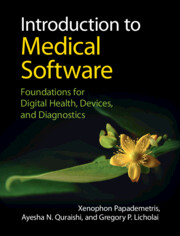Refine search
Actions for selected content:
36885 results in Cambridge Textbooks

Introduction to Medical Software
- Foundations for Digital Health, Devices, and Diagnostics
-
- Published online:
- 12 May 2022
- Print publication:
- 05 May 2022
-
- Textbook
- Export citation
24 - Gauge Field Theories and Spontaneous Symmetry Breaking
-
- Book:
- Phenomenology of Particle Physics
- Published online:
- 16 September 2022
- Print publication:
- 12 May 2022, pp 759-777
-
- Chapter
- Export citation
12 - QED Radiative Corrections
-
- Book:
- Phenomenology of Particle Physics
- Published online:
- 16 September 2022
- Print publication:
- 12 May 2022, pp 390-413
-
- Chapter
- Export citation
Epilogue
-
- Book:
- Roman Law in Context
- Published online:
- 28 April 2022
- Print publication:
- 12 May 2022, pp 189-192
-
- Chapter
- Export citation
Appendix A - Mathematical and Calculus Tools
-
- Book:
- Phenomenology of Particle Physics
- Published online:
- 16 September 2022
- Print publication:
- 12 May 2022, pp 986-994
-
- Chapter
- Export citation
Chapter 3 - Family and Inheritance
-
- Book:
- Roman Law in Context
- Published online:
- 28 April 2022
- Print publication:
- 12 May 2022, pp 37-64
-
- Chapter
- Export citation
10 - Poisson Regression
-
- Book:
- Regression for Health and Social Science
- Published online:
- 20 May 2022
- Print publication:
- 12 May 2022, pp 212-232
-
- Chapter
- Export citation
Contents
-
- Book:
- Roman Law in Context
- Published online:
- 28 April 2022
- Print publication:
- 12 May 2022, pp ix-x
-
- Chapter
- Export citation
25 - The Electroweak Theory
-
- Book:
- Phenomenology of Particle Physics
- Published online:
- 16 September 2022
- Print publication:
- 12 May 2022, pp 778-797
-
- Chapter
- Export citation
Dedication
-
- Book:
- Roman Law in Context
- Published online:
- 28 April 2022
- Print publication:
- 12 May 2022, pp vii-viii
-
- Chapter
- Export citation
Appendix E - Dirac Matrices and Trace Theorems
-
- Book:
- Phenomenology of Particle Physics
- Published online:
- 16 September 2022
- Print publication:
- 12 May 2022, pp 1036-1039
-
- Chapter
- Export citation
20 - Heavy Quarks: Charm and Bottom
-
- Book:
- Phenomenology of Particle Physics
- Published online:
- 16 September 2022
- Print publication:
- 12 May 2022, pp 626-654
-
- Chapter
- Export citation
Index
-
- Book:
- Roman Law in Context
- Published online:
- 28 April 2022
- Print publication:
- 12 May 2022, pp 219-222
-
- Chapter
- Export citation
Copyright page
-
- Book:
- Phenomenology of Particle Physics
- Published online:
- 16 September 2022
- Print publication:
- 12 May 2022, pp iv-iv
-
- Chapter
- Export citation
32 - Outlook
-
- Book:
- Phenomenology of Particle Physics
- Published online:
- 16 September 2022
- Print publication:
- 12 May 2022, pp 976-985
-
- Chapter
- Export citation
8 - Free Fermion Dirac Fields
-
- Book:
- Phenomenology of Particle Physics
- Published online:
- 16 September 2022
- Print publication:
- 12 May 2022, pp 212-259
-
- Chapter
- Export citation
Acknowledgments
-
- Book:
- Regression for Health and Social Science
- Published online:
- 20 May 2022
- Print publication:
- 12 May 2022, pp xv-xvi
-
- Chapter
- Export citation
22 - Parity Violation in Weak Interactions
-
- Book:
- Phenomenology of Particle Physics
- Published online:
- 16 September 2022
- Print publication:
- 12 May 2022, pp 693-712
-
- Chapter
- Export citation
15 - Hadrons
-
- Book:
- Phenomenology of Particle Physics
- Published online:
- 16 September 2022
- Print publication:
- 12 May 2022, pp 465-497
-
- Chapter
- Export citation
4 - Assessing the Regression
-
- Book:
- Regression for Health and Social Science
- Published online:
- 20 May 2022
- Print publication:
- 12 May 2022, pp 84-100
-
- Chapter
- Export citation
